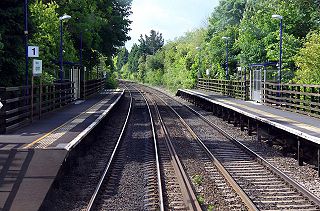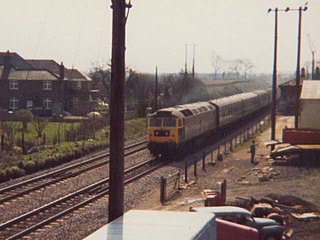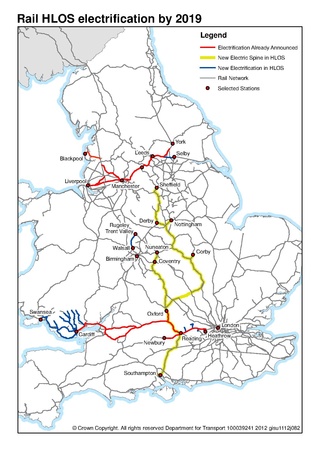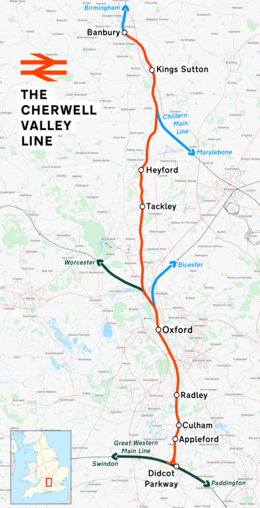
The Cotswold Line is an 86+1⁄2-mile (139.2 km) railway line between Oxford and Hereford in England.

The Chiltern Main Line is a railway line which links London (Marylebone) and Birmingham, the United Kingdom's two largest cities, by a 112-mile (180 km) route via High Wycombe, Bicester, Banbury, Leamington Spa and Solihull.

Didcot Parkway is a railway station serving the town of Didcot in Oxfordshire, England. The station was opened as Didcot on 12 June 1844 and renamed Didcot Parkway on 29 July 1985 by British Rail to reflect its role as a park and ride railhead. It is 53 miles 10 chains down the line from London Paddington and is situated between Cholsey to the east and Swindon to the west.

Oxford railway station is a mainline railway station, one of two serving the city of Oxford, England. It is about 0.5 miles (800 m) west of the city centre, north-west of Frideswide Square and the eastern end of Botley Road. It is on the line for trains between London Paddington and Hereford via Worcester Shrub Hill. It is a starting point for fast and local trains to London Paddington and London Marylebone, and for local trains to Reading, Worcester, and Banbury. It is also on the north/south Cross Country Route from Manchester Piccadilly and Newcastle via Birmingham New Street and Reading to Southampton Central and Bournemouth. The station is managed by Great Western Railway, and also served by CrossCountry and Chiltern Railways trains. Immediately to the north is Sheepwash Channel Railway Bridge over the Sheepwash Channel.

Banbury railway station serves the town of Banbury in Oxfordshire, England. The station is operated by Chiltern Railways, on the Chiltern Main Line, and has four platforms in use.

Kings Sutton railway station serves the village of King's Sutton in Northamptonshire, England. It is also one of the nearest railway stations to the town of Brackley. The station is managed by Chiltern Railways, who provide most of the services, including from London Paddington and Marylebone to Oxford and Banbury.

Heyford railway station serves the village of Lower Heyford and surrounding areas in Oxfordshire, England. It is on the Cherwell Valley Line and is ideally located for visiting the Oxford Canal and Heyford Wharf, which are both alongside. The station, and the ten trains each Monday to Saturday serving it, are operated by Great Western Railway.

Tackley railway station is on the Cherwell Valley Line in Oxfordshire, England, serving the village of Tackley and its surrounding area. Great Western Railway operates the station and all but one of the trains serving it. The exception is a weekday late night service to Banbury operated by Chiltern Railways.

Radley railway station serves the villages of Radley and Lower Radley and the town of Abingdon, in Oxfordshire, England.

Culham railway station serves the village of Culham in Oxfordshire, England. It is on the Cherwell Valley Line between Didcot Parkway and Banbury, 56 miles 17 chains (90.5 km) from London Paddington. It is served by local train services provided by Great Western Railway.

Appleford railway station serves the village of Appleford-on-Thames in Oxfordshire, England, as well as nearby settlements such as Sutton Courtenay. It is on the Cherwell Valley Line between Didcot Parkway and Banbury, 55 miles 16 chains (88.8 km) measured from London Paddington. The station and all trains serving it are operated by Great Western Railway.

Shipton-on-Cherwell is a village on the River Cherwell about 2 miles (3 km) north of Kidlington in Oxfordshire, England. The village is part of the civil parish of Shipton-on-Cherwell and Thrupp.

Oxford Road Halt was a railway station on the Varsity Line 1 mile (1.6 km) west of the hamlet of Water Eaton, Oxfordshire.
Wolvercot Platform was a halt on the Great Western Railway line between Oxford and Banbury. The line is now known as the Cherwell Valley Line or the "Oxford Canal Line".

Kidlington railway station opened in 1855 on the Oxford and Rugby Railway to serve the adjacent Oxfordshire village of Kidlington, and act as a railhead for the town of Woodstock, 2.5 miles (4.0 km) away. It became a junction station in 1890 upon the opening of the Blenheim and Woodstock Branch Line, and served the area for over 100 years before falling victim to the programme of closures initiated by the Beeching Report in 1964. Following many proposals for its reopening, a new station to serve Kidlington opened in October 2015 at Oxford Parkway on the Oxford to Bicester Line.
Abingdon Road Halt railway station was built by the Great Western Railway to serve South Hinksey, a village near Oxford.
The Birmingham and Oxford Junction Railway was an English railway line promoted by the Great Western Railway to gain a route from its southern base towards the industrial centres of the West Midlands, and in due course the north-west. It overtook another GWR subsidiary, the unbuilt Oxford and Rugby Railway, and the Birmingham Extension Railway which was to build a new independent station in the city. It was authorised in 1846 and formed a single project to connect Birmingham and Oxford.

The "Electric Spine" was the name for part of a, now largely cancelled, rolling programme of railway electrification projects in England initially estimated to cost £800 million, but later thought to cost close to £3 billion. The aim was to form 25 kV AC overhead-wire electrified links northward from the Port of Southampton to major cities in northern and central England and dry port container terminals in the Midlands. The government wanted efficient electric-hauled freight trains to compete with road haulage.

















